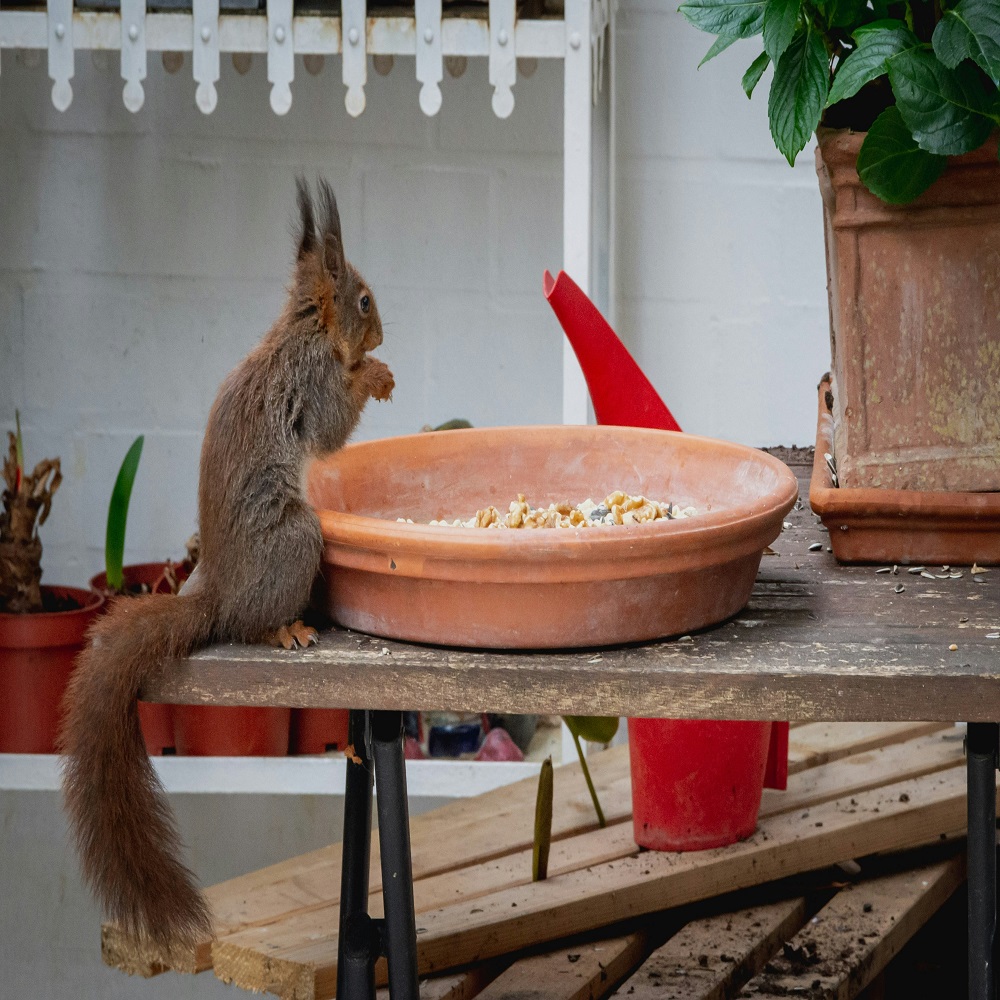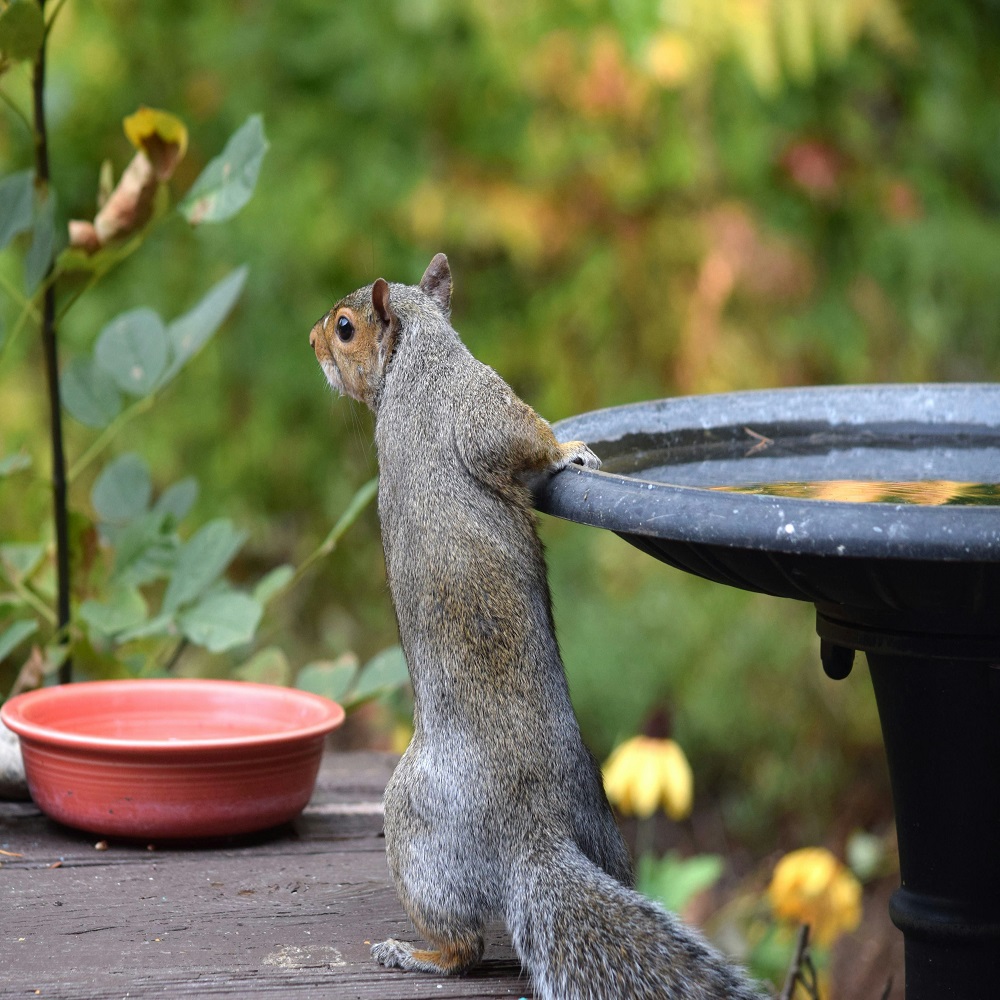The Reason Behind Squirrels Digging in Flower Pots
When squirrels invade your flower pots, it’s usually not a random act of gardening chaos. Understanding why these little critters are turning your containers into dig sites can help you address the problem effectively.
Primarily, squirrels dig in flower pots to stash their food. Items like acorns and nuts are their favorites, and the softness of potting soil makes it an ideal hiding spot. If you inspect closer, you might discover their buried treasures just a few inches deep.
Another reason for their digging could be the search for a cozy nesting place. Flower pots offer a protected environment, which is appealing to them. Moreover, squirrels might dig out of sheer curiosity or while scavenging for insects or worms, which are part of their diet.
Squirrels’ digging can be detrimental to your plants. They might unintentionally uproot them, disturb their growth, or damage delicate bulbs. This behavior increases during certain times of the year, especially when squirrels prepare for the colder months by burying more food.
Understanding these habits is the first step to safeguarding your pots. It helps create targeted solutions to keep these tenacious creatures at bay without harming them or your plants.

Natural Repellents to Deter Squirrels
To keep squirrels away from flower pots, natural repellents can be effective. One common method is to mix substances that squirrels dislike into the potting soil. Here are a few natural repellents you can use:
- Cayenne Pepper: Sprinkling cayenne pepper around the soil can discourage squirrels from approaching due to its spicy scent and taste.
- Peppermint Oil: Just a few drops of this oil in the soil or on the pot edges can repel squirrels, as they find the smell overpowering.
- Garlic: Finely chopped garlic mixed into the soil can keep squirrels at bay due to its strong odor.
- Vinegar: Although less pleasant for human noses as well, diluted vinegar around the pot can deter squirrels without harming the plants.
While using these natural repellents, remember to reapply them after rain or watering to ensure they remain effective. It’s always best to test these substances on a small part of the plant to ensure they do not cause damage. By using these techniques, you can protect your greenery from curious squirrels without resorting to harmful chemicals.
Using Physical Barriers to Protect Your Plants
Another effective way to safeguard your flower pots from squirrels is by using physical barriers. These barriers can prevent access to your plants without harming the squirrels or the environment. Here are some protective measures you can employ:
- Chicken Wire: Enclose your pots in a chicken wire cage. This blocks squirrels from reaching the soil.
- Hardware Cloth: Place hardware cloth over the soil surface to keep squirrels out yet allow plants to grow.
- Plastic Bird Netting: Cover your flower pots with bird netting. It’s light and doesn’t stop plant growth.
- Stone Layer: Add a layer of small stones on top of the potting soil. It deters squirrels from digging.
- Thorny Branches: Insert branches with thorns, like those from rose bushes, into the soil. They act as a natural deterrent.
These options protect your plants while maintaining an aesthetic garden space. You can choose a method that suits your garden’s look and feel. Make sure to secure the barriers firmly so they are effective and pose no risk to the local wildlife. Remember to check and maintain them regularly for continued protection. By using these barriers, you can enjoy squirrel-free flower pots.
Alternative Methods: Stones and Decorative Obstacles
If natural repellents fail, alternative methods like stones and decorative obstacles can help protect your flower pots from squirrels. Placing a layer of gravel or pebbles atop the soil in your container usually stops squirrels from digging. They find it difficult to move the stones, which frustrates their efforts to bury food or look for insects.
For a more aesthetic approach, consider using decorative obstacles to deter curious squirrels. Shiny objects, like old CDs or aluminum pie pans, hanging near flower pots can scare squirrels away with reflections and noise. Pinwheels or spinners add a touch of whimsy to your garden while their movement discourages squirrels. Using these items creates a dynamic barrier that’s both effective and visually appealing.
Another tip involves arranging large stones aesthetically around the plant base inside the pot. This not only stops squirrels from digging but also adds a decorative touch to your potted plants. For a creative deterrent, try placing colorful marbles or glass beads on the soil’s surface, which not only look pretty but baffle and discourage squirrels.
Incorporating these decorative yet practical elements helps keep squirrels at bay and can enhance the overall look of your garden spaces. Regularly changing the position of these items may also increase their effectiveness, as squirrels won’t get used to their presence. Try combining these methods with natural repellents for a comprehensive squirrel-deterrence strategy.

Preparing Homemade Squirrel Repellent Sprays
Homemade squirrel repellent sprays can provide an efficient solution to keep squirrels away from your flower pots. Using ingredients that are not liked by squirrels, you can create a mix that’s safe for your plants but discouraging for these persistent creatures.
Ingredients to Use in Repellent Sprays
Consider these common kitchen ingredients for your repellent spray:
- Cayenne Pepper: Known to irritate squirrels’ senses.
- Garlic: Its strong scent repels squirrels.
- Vinegar: Squirrels dislike its pungent smell.
- Peppermint Oil: Effective in deterring many pests.
Blend these ingredients into a liquid that you can spray around the soil, taking care not to get it on your plants directly as it could harm them.
Simple Recipe for Squirrel Repellant
Here’s how to make a basic squirrel repellent. You need:
- 1 tablespoon of cayenne pepper
- 2 tablespoons of garlic powder
- A few drops of peppermint oil
- 1 cup of vinegar
- 1 quart of water
Mix all ingredients and boil for about 15 minutes. Let it cool, strain through a cheesecloth, and pour into a spray bottle. Apply the spray around your pots regularly, especially after watering or rain.
Precautions While Using Repellent Sprays
When preparing and applying repellent sprays, wear gloves to protect your skin. Avoid contact with your eyes and face, as these ingredients can be irritating. Keep the spray away from children and pets. Use this homemade mix wisely, surround your greenery with care, and watch your garden stay squirrel-free.
Incorporating Plants and Mulch to Discourage Digging
Preventing squirrels from digging in flower pots can also be achieved with strategic planting and mulching. Here are some effective strategies for your garden:
Choose The Right Plants
Some plants naturally repel squirrels due to their scent or texture. Consider planting these around your containers:
- Mint: Squirrels avoid its strong smell.
- Marigolds: Their fragrance is not squirrel-friendly.
- Daffodils: They’re toxic to squirrels if ingested.
Planting these around your flower pots can create a natural barrier. It keeps squirrels away without causing them harm.
Add A Layer Of Mulch
Applying mulch over the soil in flower pots can deter squirrels. It makes it harder for them to dig. Use these mulch types:
- Straw: It’s lightweight and easy to spread.
- Bark Chips: Their texture is less inviting for squirrels.
Refresh mulch often to keep its effectiveness. Mulch also helps in retaining moisture for your plants.

Combine Plants and Mulch
Using plants and mulch together offers double protection. Place repellent plants in or near your containers. Then, cover the soil with a generous layer of mulch. This makes your pots less attractive to squirrels.
By incorporating these planting and mulching tips, you can enhance your garden’s defenses. Keep squirrels out and promote healthy plant growth at the same time.
When to Use Fertilizers Like Blood Meal Safely
While addressing the issue of squirrels digging in flower pots, gardeners may seek fertilizers that double as repellents. One such option is blood meal, a high-nitrogen byproduct that can enrich the soil and deter pests. Here’s when and how to use blood meal safely:
Optimal Timing for Applying Blood Meal
Apply blood meal when plants need a growth boost, typically at the start of the growing season. Its high nitrogen content supports robust leaf development. For flowers, application in early spring encourages vigorous growth. However, using too much or applying it at the wrong time can burn plants.
Proper Application to Avoid Attracting Squirrels
Sprinkle blood meal sparingly on top of the potting soil, away from the base of the plants. Using it in moderation can help repel squirrels without causing harm to your flowers. Mix it lightly into the top layer of soil to mask its scent from the squirrels.
Safety Precautions When Using Blood Meal
Always wear gloves when handling blood meal. Keep it away from children and pets. Follow the instructions on the label to prevent over-fertilization. Store it in a cool, dry place out of the reach of wildlife to prevent unwanted digging.
By incorporating blood meal carefully and at the right times, gardeners can bolster plant health and create a less inviting environment for squirrels. Reapply during the growing season as needed, based on plant performance and the persistence of squirrels. Always consider the specific needs of your plants and the local wildlife habits to ensure safety and effectiveness.
Understanding the Impact of Seasonal Changes on Squirrel Behavior
Seasonal changes lead to different squirrel activities. As the seasons shift, so do the reasons why squirrels dig in flower pots. During spring, they look for places to hide food. This is because they’re prepping for scarce times. In fall, they bury more to prepare for winter. As gardeners, knowing this can help us plan our defense strategies.
When it’s warm, you’ll see more digging. Squirrels are active, looking for places to cool down. Flower pots, with moist soil, seem perfect to them. This is the time to use deterrents like mulch or planting repellant plants.
In colder seasons, their behavior changes. They focus on storing food. This means they dig less for coolness and more for survival. They return to spots where they’ve stored food, like your flower pots.
To counter this, use physical barriers. Mesh or wire can protect your plants during these times. Another tip is to use seasonal decorations that move or make noise. These can scare the squirrels away without harming them.
Keep in mind, squirrels adapt quickly. They might get used to one method. Rotate through different strategies. Use repellent sprays and barriers for best results throughout the year.
By understanding these patterns, you can better protect your flower pots. And by doing so at the right times, you can minimize the impact on your plants.
